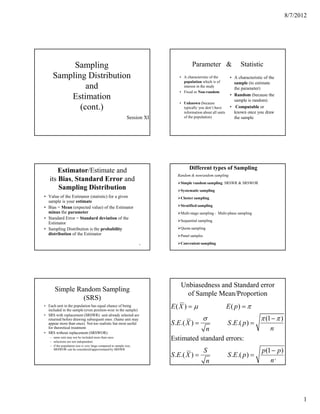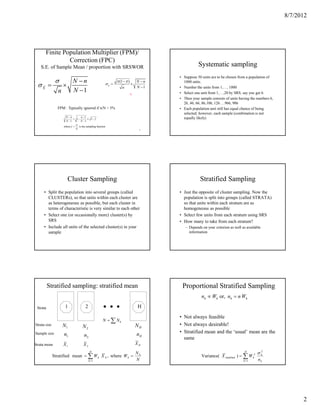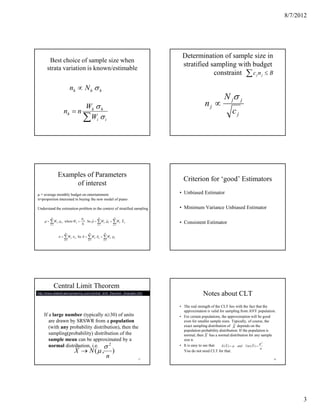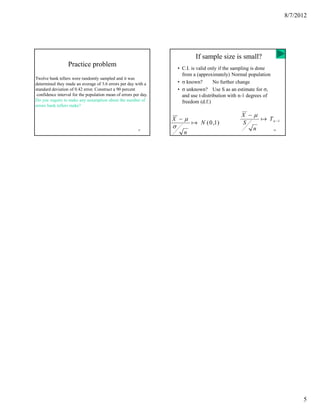This document discusses sampling distributions and estimation. It covers key concepts such as parameters versus statistics, sampling with and without replacement, unbiasedness, standard error, and the central limit theorem. It also discusses different types of sampling methods like simple random sampling, systematic sampling, stratified sampling, and cluster sampling. Confidence intervals for means and proportions are presented for simple random sampling when the population standard deviation is known and unknown.



![8/7/2012
Confidence Interval of µ
Problem
(σ known)
0.95 = P[−1.96 < Z < 1.96] Chief of Police Kathy Ackert has recently instituted a crack-
X −µ -down on drug dealers in her city. Since the crackdown began,
= P[−1.96 < < 1.96]
σ 750 of the 12,368 drug dealers in the city have been caught.
n
The mean dollar value of drugs found on these 750 dealers is
σ σ $250,000. The standard deviation of the dollar value of drugs
= P[−1.96 < X − µ < 1.96 ]
n n for these 750 dealers is $41,000. Construct for Chief Ackert a
σ σ 90 percent confidence interval for the mean dollar value of
= P[ X − 1.96 < µ < X + 1.96 ]
n n drugs possessed by the city’s drug dealers.
So, 100(1-α)% C.I. for µ is : σ Standard
X ± Zα × error
2 n
pt. estimate 19 20
table-value
Solution Solution
Want 90% C.I. for µ based on Want 90% C.I. for µ based on
X = 250 K , n = 750 , S = 41 K
X = 250 K , n = 750, N = 12368, S = 41K
So the C . I . is
So the C.I . is
41
250 ± 1 . 645 41 12368 − 750
750 250 ± 1.645 ×
750 12367
Question: Is it o.k. to replace σ by S?
= ( 247.62, 252.38)
Answer: yes, when the sample size n is large.(because S is a
consistent estimator of σ.
21 22
Strictly speaking, we should be using FPM here!
Correct interpretation of
Interesting observations about C.I.
P[247.62 < µ < 252.38] = 0.90
confidence level
• Interpretation of the confidence
coefficient/level
– how should we interpret the probability
statement? (confidence coefficient)
• Link between σ
– confidence coefficient/level L = 2 zα
– accuracy (length of the C.I.) 2 n
– sample size
σ µ
H = zα
2 n 23 24
4](https://image.slidesharecdn.com/session1112-121004052619-phpapp02/85/Session-11-12-4-320.jpg)
